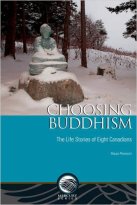Often when I’m reading Buddhist fiction, or any fiction, really, I find I take note of the history woven into the narrative. Fiction always bears historical markers. Lately I’ve been working on a paper about Buddhism in popular fiction and how certain works could be used to help fill in historical gaps. For example, while there are many ethnographic and historical texts that narrate portions of the history of Buddhism in Canada, a comprehensive history has yet to be written. There is for Buddhism in Canada, as far as I know, nothing like Rick Field’s How the Swans Came to the Lake: A Narrative History of Buddhism in America. I contend that fictional narratives can help toward compiling a history of Buddhism in Canada. Fiction relates history in a rich way, capturing the “emotional traces”* of lived experiences in a narrative form that is engaging but is sometimes sidelined by the political and colonial concerns of historians.
Since narrative history is akin to good storytelling, it is by far my favourite type of history to read. So you can imagine how happy I am to report that the Canadian Museum of History, in partnership with the University of Ottawa Press, just published a new text in their Mercury Series entitled Choosing Buddhism: The Life Stories of Eight Canadians. This work by Mauro Peressini helps fill in some of the many gaps in the history of Buddhism in Canada. Here’s the blurb:
“This book presents the life stories of eight Canadians who chose to convert to Buddhism. They were amongst the first Canadians to have chosen Buddhism, encountering this spirituality between the late 1960s and the 1980s. All became ordained or lay Buddhist teachers, having embraced Buddhist teachings and practices in their daily lives. The eight Canadians featured in the book are Ajahn Viradhammo, Jim Bedard, Albert Low, Taigen Henderson, Zengetsu Myokyo, Louise Cormier, Kelsang Drenpa and Tsultrim Palmo. The book is heavily illustrated and addresses the Buddhist traditions of Theravada, Zen and Tibetan Vajrayana. The book also includes significant contextual material regarding the history of Buddhism in Canada and various Buddhist notions and practices.”
You can order the book on Amazon.ca or here: https://www.historymuseum.ca/boutique/product/choosing-buddhism-the-life-stories-of-eight-canadians/
If you have any thoughts about the connections between fiction, history, and Buddhism, please feel free to comment. Or maybe just see what you notice the next time you’re reading a work of Buddhist fiction. Even works of science fiction and fantasy have historical markers, because nothing is written in a vacuum.
* The concept of emotional traces in fiction is taken from Laurie J. Sears’ book Situated Testimonies: Dread and Enchantment in an Indonesian Literary Archive. University of Hawaii Press, 2013.


